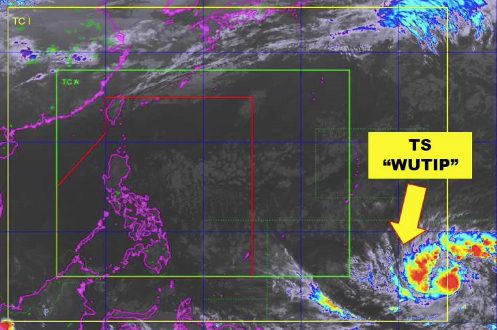SUMMARY
This is AI generated summarization, which may have errors. For context, always refer to the full article.

What’s the weather like in your area? Report the situation through Rappler’s Agos or tweet us at @rapplerdotcom.
MANILA, Philippines – Forecasters are monitoring a tropical storm outside the Philippine Area of Responsibility (PAR), with the international name Wutip.
The Philippine Atmospheric, Geophysical, and Astronomical Services Administration (PAGASA) earlier said Tropical Storm Wutip is located more than 3,000 kilometers east of Mindanao, still far from PAR.
In the 110th Climate Outlook Forum on Wednesday, February 20, PAGASA Weather Specialist Raymond Ordinario said Wutip could intensify since it is over water.
Ordinario also explained that since the tropical storm is still far from land, various models are showing different scenarios at the moment.
Wutip might move generally northwest in the next few days, according to Ordinario.
He then gave two possible scenarios:
- Wutip would approach PAR, but recurve toward the east, away from the Philippines.
- Wutip could enter PAR, but it may weaken as it interacts with cold air and eventually become a low pressure area.
Ordinario said both scenarios mean Wutip would have no significant effect on the country.
The public, however, should continue monitoring weather updates in case there are any changes to the forecast.
So far, the Philippines has had one tropical cyclone in 2019 – Tropical Depression Amang. The next tropical cyclone that enters or develops within PAR will be named Betty. (READ: LIST: PAGASA’s names for tropical cyclones in 2019)
The country gets an average of 20 tropical cyclones per year, but PAGASA expects only 14 to 18 in 2019. The number is likely to be below average as the state weather bureau is already in the El Niño Advisory stage, the last stage before declaring El Niño. (READ: PAGASA warns of ‘full-blown’ El Niño in 2019)
Below is the estimated number of tropical cyclones for the next 6 months:
- March – 0 or 1
- April – 0 or 1
- May – 1 or 2
- June – 1 or 2
- July – 2 or 3
- August – 2 or 3
– Rappler.com
Add a comment
How does this make you feel?
There are no comments yet. Add your comment to start the conversation.